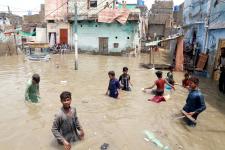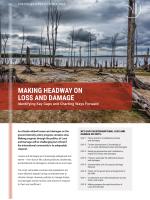Three quick questions about Loss and Damage

What is Loss and Damage?
Basically, Loss and Damage covers the harm that occurs as a result of climate change, whereas the concepts of Mitigation and Adaptation (which we talk a lot about) are about preventing and adapting to the effects of climate change.
That said, there are major disagreements about how Loss and Damage should be understood and handled.
Historically, the concept of support to deal with serious climate change losses was introduced in 1991 by the small island states, who predicted that they would eventually be flooded in a way that they could neither prevent nor adapt to. Nevertheless, Loss and Damage was not included in the UNFCCC when it was established the following year.
In the years since, it has proved difficult for countries to agree on a definition under the Convention. Only in 2007 was the term officially used in a UNFCCC document, the so-called Bali Action Plan, and to this day a clear definition is still lacking under the Convention.
Why is it so hard to agree on what Loss and Damage is and how to use the term?
When you look at climate reports, you sometimes see "Loss and Damage" with capital letters and sometimes "loss and damage" in lowercase. It may sound like an inconsequential detail, but it actually indicates two very different things.
"Loss and damage" is used to refer to the concrete losses and damages we’re see around the world. The latest major climate report from the IPCC clearly documents widespread harm to – in some cases even destruction of –ecosystems, species and human societies due to climate change.
Yet disagreement arises regarding "Loss and Damage" in capital letters. Because this is a policy issue under the UN's climate convention, which involves questions of responsibility and, not least, financing. And this is where agreement between the countries stops.
Many countries in the Global South are pushing for the concept to take up more space in the climate negotiations and for more support to be provided to respond to the losses and damages they experience, both through technical support and finance.
Conversely, many countries in the Global North are reluctant. They have not supported calls to include Loss and Damage finance on the official agenda or to establish specific mechanisms dedicated to addressing loss and damage. Instead, they often emphasise the utility of existing concepts and mechanisms, for example suggesting increased focus to Mitigation and Adaptation to prevent further loss and damage and adjusting existing mechanisms – rather than establishing new – to respond to those losses and damages which are occurring.
So where does Loss and Damage stand now and what is the future of it?
During COP19 in Poland in 2013, the Warsaw International Mechanism for Loss and Damage (WIM) was created. The WIM was established under the climate convention to increase knowledge about losses and damage, strengthen dialogue and coordination, and ensure action and support. But especially on the last point, action and support, WIM has been critiqued for underdelivering.
In 2019, the Santiago Network was established to act as a catalyst to ensure technical support to respond to losses and damages in developing countries. But the network has not been operationalized yet, and there remain disagreements about its structure and governance. This will be further negotiated at COP27.
Finally, during COP26 in Glasgow in 2021, the Glasgow Dialogue was established. It is a dialogue process in which countries discuss financing mechanisms for developing countries that experience losses and damages as a result of climate change. The first dialogue session took place in Bonn in June 2022, but without consensus on a clear way forward on financing mechanisms for loss and damage. The next session will take place in Bonn in June 2023.
In recent years, Loss and Damage has become more central to the negotiations between the global North and South, but it is still far from clear how it will develop and in what way countries can make concrete progress on core aspects of this complex issue.
You can read more about Loss and Damage in our policy brief and our report on the subject.
DIIS Experts


